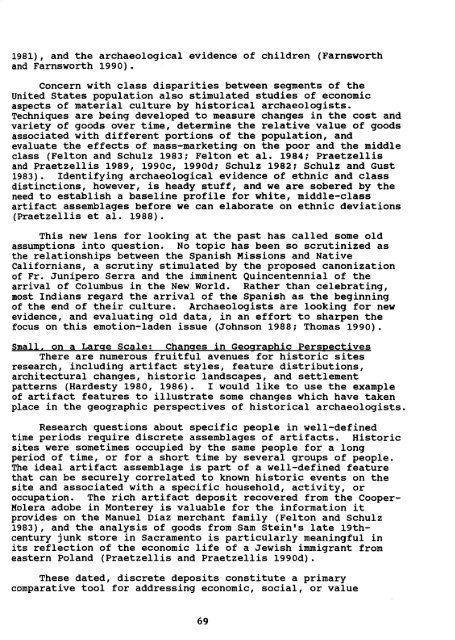SOME OBSERVATIONS ON THE DEVELOPMENT OF HISTORICAL ...
SOME OBSERVATIONS ON THE DEVELOPMENT OF HISTORICAL ...
SOME OBSERVATIONS ON THE DEVELOPMENT OF HISTORICAL ...
Create successful ePaper yourself
Turn your PDF publications into a flip-book with our unique Google optimized e-Paper software.
1981), and the archaeological evidence of children (Farnsworth<br />
and Farnsworth 1990).<br />
Concern with class disparities between segments of the<br />
united states population also stimulated studies of economic<br />
aspects of material culture by historical archaeologists.<br />
Techniques are being developed to measure changes in the cost and<br />
variety of goods over time, determine the relative value of goods<br />
associated with different portions of the population, and<br />
evaluate the effects of mass-marketing on the poor and the middle<br />
class (Felton and Schulz 1983; Felton et al. 1984; Praetzellis<br />
and Praetzellis 1989, 1990c, 1990d; Schulz 19821 Schulz and Gust<br />
1983). Identifying archaeological evidence of ethnic and class<br />
distinctions, however, is heady stuff, and we are sobered by the<br />
need to establish a baseline profile for white, middle-class<br />
artifact assemblages before we can elaborate on ethnic deviations<br />
(Praetzellis et al. 1988).<br />
This new lens for looking at the past has called some old<br />
assumptions into question. No topic has been so scrutinized as<br />
the relationships between the Spanish Missions and Native<br />
Californians, a scrutiny stimulated by the proposed canonization<br />
of Fr. Junipero Serra and the imminent Quincentennial of the<br />
arrival of Columbus in the New World. Rather than celebrating,<br />
most Indians regard the arrival of the spanish as the beginning<br />
of the end of their culture. Archaeologists are looking for new<br />
evidence, and evaluating old data, in an effort to sharpen the<br />
focus on this emotion-laden issue (Johnson 1988; Thomas 1990).<br />
Small, on a Large Scale: Changes in Geographic Perspectives<br />
There are numerous fruitful avenues for historic sites<br />
research, including artifact styles, feature distributions,<br />
architectural changes, historic landscapes, and settlement<br />
patterns (Hardesty 1980, 1986). I would like to use the example<br />
of artifact features to illustrate some changes which have taken<br />
place in the geographic perspectives of historical archaeologists.<br />
Research questions about specific people in well-defined<br />
time periods require discrete assemblages of artifacts. Historic<br />
sites were sometimes occupied by the same people for a long<br />
period of time, or for a short time by several groups of people.<br />
The ideal artifact assemblage is part of a well-defined feature<br />
that can be securely correlated to known historic events on the<br />
site and associated with a specific household, activity, or<br />
occupation. The rich artifact deposit recovered from the Cooper<br />
Molera adobe in Monterey is valuable for the information it<br />
provides on the Manuel Diaz merchant family (Felton and Schulz<br />
1983), and the analysis of goods from Sam stein's late 19thcentury<br />
junk store in Sacramento is particularly meaningful in<br />
its reflection of the economic life of a Jewish immigrant from<br />
eastern Poland (Praetzellis and Praetzellis 1990d).<br />
These dated, discrete deposits constitute a primary<br />
comparative tool for addressing economic, social, or value<br />
69
















